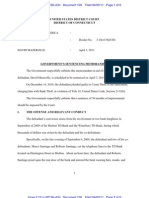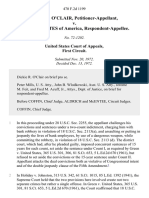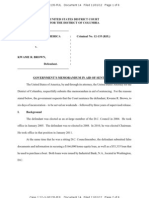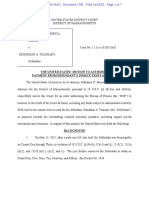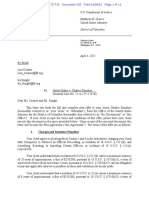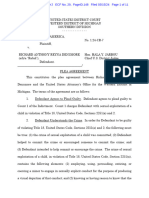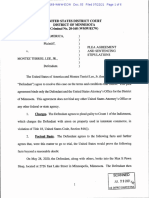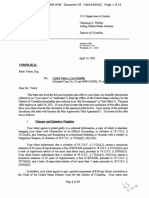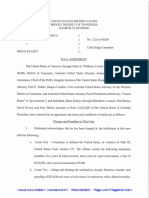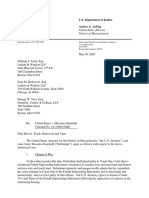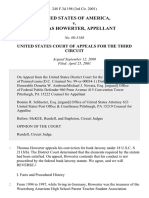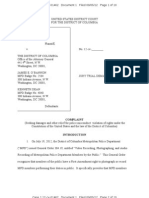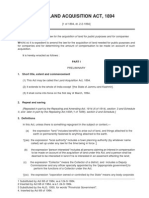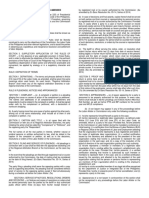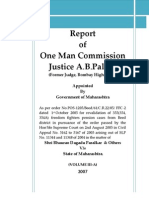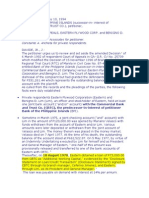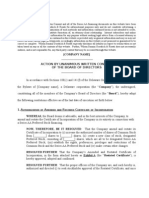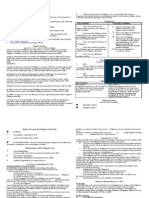Professional Documents
Culture Documents
Frank Reddick Sentencing Memo
Uploaded by
Del WilberOriginal Title
Copyright
Available Formats
Share this document
Did you find this document useful?
Is this content inappropriate?
Report this DocumentCopyright:
Available Formats
Frank Reddick Sentencing Memo
Uploaded by
Del WilberCopyright:
Available Formats
Case 1:08-cr-00342-RWR-DAR Document 12
Filed 03/05/09 Page 1 of 11
UNITED STATES DISTRICT COURT FOR THE DISTRICT OF COLUMBIA UNITED STATES OF AMERICA v. FRANK LESTER REDDICK, Defendant. : : : : Criminal Case No. 08-342 (RWR)
UNITED STATES MEMORANDUM IN AID OF SENTENCING The United States of America, by and through its attorney, the United States Attorney for the District of Columbia, hereby respectfully submits its Memorandum in Aid of Sentencing, recommending that the defendant be sentenced to a total of 82 months of incarceration, followed by 3 years of supervised release and/or probation, as appropriate. Further, the government requests that as part of the defendants supervised release and/or probation conditions, the defendant be required to make restitution as contemplated by statute and by the plea agreement, to comply with other court orders, and to attend anger management and/or domestic violence intervention classes. In support thereof, the United States respectfully states the following: Background 1. The defendant pleaded guilty to five offenses: (a) Bank Robbery, in violation of
18 U.S.C. 2113(a) (Count 1); (b) Robbery, in violation of 22 D.C. Code 2801 (Count 2); (c) Assault, in violation of 22 D.C. Code 404 (Count 3); (d) Attempted Theft, in violation of 22 D.C. Code 1803, 3211, and 3212(b) (Count 4); and Escape, in violation of 22 D.C. Code 2601 (Count 5). These charges are the result of a four-month crime spree by the defendant, from May to September of 2008, during which time he persisted in a pattern of robbery, assault, and evasion of authorities. In summary:
Case 1:08-cr-00342-RWR-DAR Document 12
Filed 03/05/09 Page 2 of 11
On May 5, 2008, the defendant walked into the Landmark E Street Cinema, handed the cashier a note claiming that he had a gun and demanding cash, and then robbed the cinema of $446.00.1 The defendant returned and did the same thing again on June 20, 2008, this time taking a total of $439.50 from the cinema. (Count 2). The very next day, on June 21, 2008, the defendant went to Georgetown University Hospital to see Ms. Kadaira Blakes, who had given birth to their child a few days earlier. During an argument over money, the defendant became angry, grabbed at the diaper bag in which he believed the money had been placed, pushed Ms. Blakes, punched her in the back of the head, and shook her.2 (Count 3). Three days later, on June 24, 2008, the defendant walked into Capitol Eyes, an eyeglass store located in the District of Columbia, handed an employee a robbery note stating that he had a gun in his pocket, and that he would shoot if the victim refused to turn over the money. In that case, the employee fled, so the defendant left the store without any money. (Count 4). On September 10, 2008, while he was remanded to a halfway house, the defendant walked into a District of Columbia branch of Chevy Chase Bank and handed the teller a withdrawal slip and a note that read, I have a gun and I am going to shoot threw [sic] the window. I want 2,000 in 100s. He robbed the bank of $2,600.00.3 Two days later, on September 12, 2008, the defendant ran away from the halfway house to which he had been transferred on July 7, 2008, and never returned. (Count 5). On September 15, 2008, the defendant walked into a District of Columbia branch of Wachovia Bank, walked up to a teller, and presented a note stating, Look, I have a gun. Just give me money, or I will shoot and kill. $100 dollar bills and $50 is what I want. When the teller looked at the defendant in disbelief, the defendant lifted up his shirt in a manner that suggested to the teller that the
! !
No charges are being brought on account of this robbery as part of the plea agreement. Although the defendant attempted to minimize his conduct during the plea proffer, these events were all witnessed by a nurse who came into the room and had to pull the defendant off of Ms. Blakes. No charges are being brought on account of this robbery as part of the plea agreement. 2
Case 1:08-cr-00342-RWR-DAR Document 12
Filed 03/05/09 Page 3 of 11
defendant had a gun in his waistband. The defendant then stated, Give me ten $100 bills and ten $50 bills. He robbed Wachovia of $3,121.00. (Count 1). This crime spree ended only when the defendant was arrested on September 16, 2008, and from all appearances, only because he was held without bond at that point. Statutory Penalties 2. Federal Offense. Count 1, the charge of Bank Robbery, carries a maximum
sentence of twenty years of imprisonment, a fine of $250,000 or a fine of twice the pecuniary gain or loss pursuant to 18 U.S.C. 3571(d), and an obligation to pay any applicable interest or penalties on fines not timely made and a term of up to three years of supervised release. In addition, the defendant must pay a special assessment of $100 per felony conviction to the Clerk of the United States District Court for the District of Columbia prior to the date of sentencing. The defendant is eligible for a term of probation of no less than one year and no more than five years. 18 U.S.C. 3561(c)(1). The defendant must pay restitution to Wachovia Bank. 18
U.S.C. 3663A.4 3. District of Columbia Offenses. Count 2, the charge of Robbery, carries a
minium sentence of two years of imprisonment, a maximum sentence of fifteen years of imprisonment pursuant to 22 D.C. Code 2801, and a term of up to three years of supervised release pursuant to 24 D.C. Code 403.01. Count 3, the charge of Simple Assault, carries a
Paragraph 90 of the presentence report indicates that the defendant must pay restitution to both Chevy Chase Bank and to Wachovia Bank. As Wachovia Bank is the named victim of the charged bank robbery, the government agrees that restitution to Wachovia Bank in the amount of $3,121.00 is mandatory, pursuant to 18 U.S.C. 3663A(a)(1) and (c). However, the agreement does not require the defendant to make restitution to Chevy Chase Bank, the victim of the bank robbery that will be dismissed as part of the plea agreement. Accordingly, it does not appear that restitution to Chevy Chase Bank is required. See 18 U.S.C. 3663A(a)(3) (requiring restitution to non-victims only where making such restitution is a requirement of the plea agreement). 3
Case 1:08-cr-00342-RWR-DAR Document 12
Filed 03/05/09 Page 4 of 11
maximum sentence of 180 days of imprisonment and/or a $1,000 fine, pursuant to 22 D.C. Code 404. Count 4, the charge of Attempted Theft carries a maximum sentence of 180 days of imprisonment and/or a $1,000 fine pursuant to 22 D.C. Code 1803, 3211, and 3212(b). Count 5, the charge of Escape, carries a maximum sentence of five years of imprisonment and/or a $5,000 fine, pursuant to 22 D.C. Code 2601, and a term of up to three years of supervised release, pursuant to 24 D.C. Code 403.01. In addition, pursuant to 4 D.C. Code 516, the defendant must pay an assessment of between $100 and $5,000 for each D.C. Code felony offense (Counts 2 and 5), and of between $50 and $250 for each D.C. Code misdemeanor offense (Counts 3 and 4), into the District of Columbia Superior Court Victims of Violent Crime Compensation Fund. The defendant is eligible for a term of probation of up to five years for each D.C. Code offense. Should the Court choose to impose a term of probation, the Court may (1) suspend imposition of sentence; (2) impose the sentence and suspend imposition of the sentence; o4 (3) impose the sentence and suspend the execution of a portion of the sentence. 16 D.C. Code 710 and 710(b). Sentencing Guidelines 3. Federal Offense. With respect to Count 1, Bank Robbery, the Presentence
Report writer has calculated defendants base offense level to be 20. PSR 26. The PSR writer enhanced the base level by 2 more points because the robbery involved a financial institution. PSR 27 (citing U.S.S.G. 2B3.1(b)(1)).5 The PSR writer also added 2 points for a threat of
Although this specific offense characteristic was not included in the plea agreement, the government agrees that the enhancement is appropriate and should be applied. This is consistent with the language in the plea agreement stating that nothing in the agreement is to be read as precluding either party from arguing for or against the applicability of any other specific offense characteristic and/or adjustment to the defendants base offense level that is not specifically referenced in the agreement. 4
Case 1:08-cr-00342-RWR-DAR Document 12
Filed 03/05/09 Page 5 of 11
death enhancement, on the basis that the defendant claimed to have a gun and threatened to shoot and kill the teller. PSR 28 (citing U.S.S.G. 2B3.1(b)(2)(F)). In fact, the enhancement for this conduct should be 3 points, as contemplated by the specific offense characteristic for possessing or brandishing a dangerous weapon. See U.S.S.G. 2B3.1(b)(2)(E) and Application Note 1(D) to 1B1.1. The defendants threatening words that he had a gun, combined with his admitted gesture in pulling on his waistband, caused the teller reasonably to believe that the defendant had a gun in his waistband.6 With this change, the defendants adjusted offense level is 25, not 24, as contemplated by the presentence report. See PSR 32. Thus, after a 3-point reduction for his early acceptance of responsibility, the defendants total offense level is 22. With a criminal history category of I, the defendants Guidelines range for Bank Robbery is 41 to 51 months. The guideline range for a term of supervised release is at least two but no more than three years. PSR 73. 4. District of Columbia Offenses. The District of Columbia Sentencing
Commissions Voluntary Sentencing Guidelines (D.C. Guidelines) apply only to felonies, and
The parties stipulated to this enhancement in the plea agreement. As stated in Application Note 2 to U.S.S.G. 2B3.1, an object shall be considered to be a dangerous weapon if the defendant used the object in a manner that created the impression that the object was an instrument capable of inflicting death or serious bodily injury (e.g., a defendant wrapped a hand in a towel during a bank robbery to create the appearance of a gun). It is irrelevant whether the defendant intended to give a false impression that he had a dangerous weapon or did so inadvertently. The test is whether a reasonable person, under the circumstances of the robbery, would have regarded the object that the defendant brandished, displayed or possessed as a dangerous weapon, as the teller did here. See, e.g., United States v. Stitman, 472 F.3d 983 (7th Cir. 2007). In Stitman, the defendant conceded that he told the teller that he had a gun, and that the teller may have observed a bulge in his pocket, but he argued that he merely had his hand in his pocket and was not in possession of any type of object that a reasonable person could have perceived as a dangerous weapon. The Seventh Circuit nevertheless determined that the sentencing enhancement for brandishing or possessing a weapon in connection with a robbery offense applied. Id. at 986-87. 5
Case 1:08-cr-00342-RWR-DAR Document 12
Filed 03/05/09 Page 6 of 11
thus would only apply to Count 2 (Robbery) and Count 5 (Escape) in this case. With a criminal history score of 0 points, the guideline range for Count 2 (Robbery) is 18 to 60 months, and a sentence in this range allows for a term of imprisonment or a short split sentence (but not straight probation). PSR 66. The guideline range for Count 5 (Escape) is 1 to 12 months, and a sentence in this range allows for a term of imprisonment, a short split sentence, or probation. Under the D.C. Guidelines, the Court has discretion to sentence the robbery and escape charges consecutively or concurrently. See D.C. Guidelines, Chapter 6 (Consecutive and Concurrent Sentences).7 Sentencing Recommendation 5. Considering the sentencing factors enumerated in 18 U.S.C. 3553(a), the
guidelines and policies promulgated by the United States Sentencing Commission and the District of Columbia Sentencing Commission, and given the nature and circumstances of the defendants repeated criminal actions in these cases, the government requests that the Court sentence the defendant to a total of 82 months of incarceration, followed by 3 years of supervised release and/or probation, as appropriate. Further, the government requests that as part of the defendants supervised release and/or probation conditions, the defendant be required to make restitution as contemplated by statute and by the plea agreement, to comply with other court orders, and to attend anger management and/or domestic violence intervention classes. 6. To be specific, on the charge of Bank Robbery (Count 1), the defendant should be
sentenced to 46 months of incarceration, followed by 3 years of supervised release, and the
Although both parties have agreed not to seek a sentence outside of any applicable guidelines range, the government recognizes that there is no authority which requires the Court to consult or to consider the D.C. Guidelines with respect to the D.C. Code offenses. 6
Case 1:08-cr-00342-RWR-DAR Document 12
Filed 03/05/09 Page 7 of 11
defendant should be ordered to make restitution to Wachovia Bank in the amount of $3,121.00. On the charge of Robbery (Count 2), the defendant should be sentenced to 24 months of incarceration, to run consecutive to all other counts, and 3 years of supervised release, to run concurrent to any other period of supervised release or probation. Consistent with the plea agreement, the defendant should also be ordered to make restitution to Landmark E Street Cinema in the amount of $885.50. On the charge of Simple Assault (Count 3), the defendant should be sentenced to 6 months of incarceration, to run consecutive to all other counts, with execution of 3 months of the sentence suspended. The defendant should be placed on three years of probation, to run concurrent to any period of supervised release, during which time he must participate in anger management and/or domestic violence intervention classes. As
contemplated by the plea agreement, the defendant should also be required to comply with the terms of Civil Protection Order 08CPO2105, issued by the District of Columbia Superior Court on July 23, 2008 (or any subsequent similar order). A copy of that order is attached as Exhibit A. On the charge of Attempted Theft (Count 4), the defendant should be sentenced to 3 months of incarceration, to run consecutive to all other counts. On the charge of Escape (Count 5), the defendant should be sentenced to 6 months of incarceration, to run consecutive to all other counts, followed by 3 years of supervised release, to run concurrent to any other period of supervised release or probation. 7. With respect to the federal charge of Bank Robbery (Count 1), the Court should
begin . . . by correctly calculating the applicable Guidelines range. United States v. Gall, 128 S. Ct. 586, 594 (2007) (citation omitted). The Guidelines are the product of careful study based on extensive empirical evidence derived from the review of thousands of individual sentencing decisions and are the starting point and the initial benchmark. Id. at 594-596 (citation and 7
Case 1:08-cr-00342-RWR-DAR Document 12
Filed 03/05/09 Page 8 of 11
footnote omitted). Indeed, the Guidelines themselves are designed to calculate sentences in a way that implements the considerations relevant to sentencing as articulated in Title 18, United States Code, Section 3553(a). United States v. Rita, 127 S. Ct. 2456, 2463-2465 (2007). With respect to all of the offenses to which the defendant pleaded guilty, the Court should next consider all of the applicable factors set forth in Section 3553(a). 8. The Section 3553(a) factors include (1) the nature and circumstances of the
offense and the history and characteristics of the defendant, (2) the need for the sentence imposed to reflect the seriousness of the offense, to provide just punishment for the offense, to afford adequate deterrence to criminal conduct, to protect the public from further crimes of the defendant, and to provide the defendant with needed correctional treatment, (3) the Sentencing Guidelines and related Sentencing Commission policy statements, and (4) the need to avoid unwarranted sentence disparities. 9. The government is requesting a sentence at the middle of the defendants
applicable guidelines range on Counts 1, 2, and 5, and in the middle of the defendants potential statutory sentencing range on Counts 3 and 4 (to which no guidelines apply). Such a sentence is more than supported by the facts surrounding defendants offenses, the risk created to citizens by the defendants conduct, the defendants repeated violations of law (even after being arrested and placed on conditions of release), and the current threat that the defendant poses to the community. 10. Over a four-month period, the defendant repeatedly committed dangerous crimes
that placed lives at risk. He committed or attempted to commit five robberies, each time threatening that he had a gun, and the last time, gesturing in a manner to indicate that he had a gun in his waistband. In a dispute over money, he assaulted the mother of his child, who had just 8
Case 1:08-cr-00342-RWR-DAR Document 12
Filed 03/05/09 Page 9 of 11
given birth and was recovering in a hospital room. His acts of violence went undeterred even after he was arrested and placed in a halfway house. To the contrary, after he had been arrested for the cinema robberies and the assault on Ms. Blakes, and while under Superior Court supervision, he escalated his crimes. In a five-day period in September of 2008, he robbed two banks of over $5,000 in total, and escaped from the halfway house. His criminal conduct ceased only when he was arrested a second time, and then only because he was held without bond. 11. In sentencing the defendant, this Court should consider not only the harm to the
victims of the defendants crimes the movie theater cashiers, the bank tellers, and Ms. Blakes but also the potential harm the defendants actions may have caused to the community. By participating in robberies in highly populated areas such as movie theaters and banks, the defendant put numerous lives at risk. It is exceptionally fortunate that no weapons were drawn in response to the defendants threats, and that no one was injured. 12. The Court should also consider the harm that the defendant would pose to the
community if he were released. The defendant appears to show no remorse for his conduct in robbing the movie theater twice and in robbing two banks. To the contrary, he was quite arrogant about his criminal successes, stating on his MySpace.com page that his current occupation was Gettin Money!!!!!!!!!!!!!, while posting photographs of a semi-automatic pistol, enormous wads of cash, and a mountain of suspected marijuana. A copy of the relevant excerpts from the defendants MySpace.com page is attached as Exhibit B. Moreover, when the defendant pleaded guilty, he attempted to minimize his conduct to this Court. He claimed that it was sheer coincidence that he happened to pull on his waistband when the Wachovia Bank teller looked at him in disbelief after he passed her a demand note. Given the defendants evident
Case 1:08-cr-00342-RWR-DAR Document 12
Filed 03/05/09 Page 10 of 11
pride in his work, and his minimizing of his conduct to this Court, there is no reason to believe he will be deterred from repeating the same kind of conduct again upon release. 13. In the same vein, the defendant appears to remain a significant threat to Ms.
Blakes. During the plea colloquy, he minimized the nature of his assaultive conduct toward Ms. Blakes when he stated that he punched Ms. Blakes by accident and that he only shook her gently. His statements in this regard appear directly at odds with the pattern of behavior described by Ms. Blakes, who told to the presentence report writer that the defendant has assaulted her on five other occasions, including one instance where he broke her cell phone, threw it at her, and then threatened to kill her and burn her house. PSR 19. In addition, notwithstanding the fact that Ms. Blakes: (a) obtained a Civil Protection Order against the defendant on July 23, 2008, (b) told the presentence report writer that her relationship with the defendant ended in November of 2008, (c) describes the defendant as a liar and a thief, who has serious problems, and (d) states that the defendant may not live with her at the conclusion of these cases, the defendant reports that he intends to live with Ms. Blakes after he is released from prison in these cases. See PSR 48-49. He is clearly deluded about the nature of their relationship, and there is a danger that a reality check will lead him to commit further violent acts against her. In short, it appears that the public and Ms. Blakes will be safe from the defendant only while the defendant is incarcerated. 14. The defendant has received a substantial benefit from this plea, and all the
leniency he should receive is encompassed in the plea. With respect to Count 1, the defendant received a three point decrease in his offense level as a result of his acceptance of responsibility. Moreover, the defendant will not face charges or be sentenced for his admitted robbery of E Street Cinema on May 5, 2008, his admitted robbery of Chevy Chase Bank on September 10, 10
Case 1:08-cr-00342-RWR-DAR Document 12
Filed 03/05/09 Page 11 of 11
2008, or for violating his release conditions in Superior Court by committing crimes while under Superior Court supervision. Additionally, the governments request for a middle range sentence reflects some leniency for the defendants having pleaded guilty. 15. In sum, the government believes that the requested term of incarceration will give
both the government and the defendant the benefit of the bargain negotiated, while also ensuring that the defendant is appropriately punished and that society is protected. WHEREFORE, based upon the above, and the information reflected in the Presentence Report, the United States respectfully recommends a sentence of 82 months of incarceration, followed by 3 years of supervised release and/or probation, as appropriate, and that as part of the defendants supervised release and/or probation conditions, the defendant be required to make restitution as contemplated by statute and by the plea agreement, to comply with other court orders, and to attend anger management and/or domestic violence intervention classes. Respectfully, JEFFREY A. TAYLOR United States Attorney
/s/ EMILY A. MILLER Assistant United States Attorney Federal Major Crimes Section 555 4th Street, N.W. #4237 Washington, DC 20530 Phone: 514-7533; Fax: 514-6010 D.C. Bar No. 462077
11
You might also like
- NIXON Robert Govt Sentencing MemoDocument14 pagesNIXON Robert Govt Sentencing MemoHelen BennettNo ratings yet
- USA V Basim Sabri Sentencing Stipulations 2Document9 pagesUSA V Basim Sabri Sentencing Stipulations 2ghostgripNo ratings yet
- Mazerolle Prosecution MemoDocument6 pagesMazerolle Prosecution MemoThe Valley IndyNo ratings yet
- United States District Court Eastern District Kentucky Central Division Lexington Criminal Action No. 5:23-Cr-24-Kkc-Eba States AmericaDocument9 pagesUnited States District Court Eastern District Kentucky Central Division Lexington Criminal Action No. 5:23-Cr-24-Kkc-Eba States AmericaThe Lexington Times100% (1)
- Dickie R. O'Clair v. United States, 470 F.2d 1199, 1st Cir. (1972)Document8 pagesDickie R. O'Clair v. United States, 470 F.2d 1199, 1st Cir. (1972)Scribd Government DocsNo ratings yet
- Federal Prosecutors' Sentencing Memo in Case of Kwame R. Brown, Former D.C. Council ChairmanDocument6 pagesFederal Prosecutors' Sentencing Memo in Case of Kwame R. Brown, Former D.C. Council ChairmanDel WilberNo ratings yet
- Plea Letter For Huttle, Matthew Filed 8/10/23Document11 pagesPlea Letter For Huttle, Matthew Filed 8/10/23Indiana Public Media NewsNo ratings yet
- Show Temp - PLDocument9 pagesShow Temp - PLThe Lexington TimesNo ratings yet
- United States v. Lee Sellers, 42 F.3d 116, 2d Cir. (1994)Document10 pagesUnited States v. Lee Sellers, 42 F.3d 116, 2d Cir. (1994)Scribd Government DocsNo ratings yet
- Tsarnaev $Document9 pagesTsarnaev $HerridgeNo ratings yet
- United States v. Jackson, 10th Cir. (2010)Document5 pagesUnited States v. Jackson, 10th Cir. (2010)Scribd Government DocsNo ratings yet
- Skeeter Manos Sentencing MemoDocument15 pagesSkeeter Manos Sentencing MemoMatt DriscollNo ratings yet
- Tobin 2018 11 07 Change of PleaDocument10 pagesTobin 2018 11 07 Change of Plea925892580% (1)
- Charles Donohoe Plea AgreementDocument14 pagesCharles Donohoe Plea AgreementDaily KosNo ratings yet
- Federal Court Case No. 05-2288 CATERBONE v. Lancaster County Prison, Fulton Bank, Et. Al., OPEN Case and U.S. Third Circuit Reversal of Dismissal For May 6, 2016Document100 pagesFederal Court Case No. 05-2288 CATERBONE v. Lancaster County Prison, Fulton Bank, Et. Al., OPEN Case and U.S. Third Circuit Reversal of Dismissal For May 6, 2016Stan J. CaterboneNo ratings yet
- Cherry v. Amoco Oil Co._ 481 F. Supp. 727Document6 pagesCherry v. Amoco Oil Co._ 481 F. Supp. 727Ethan MooreNo ratings yet
- District of Columbia: 1. Charges and Statutory PenaltiesDocument11 pagesDistrict of Columbia: 1. Charges and Statutory PenaltiesJ RohrlichNo ratings yet
- United States v. Howard, 10th Cir. (2015)Document11 pagesUnited States v. Howard, 10th Cir. (2015)Scribd Government DocsNo ratings yet
- United States v. Jack Bryan, 3rd Cir. (2010)Document7 pagesUnited States v. Jack Bryan, 3rd Cir. (2010)Scribd Government DocsNo ratings yet
- Oath Keeper William Todd Wilson Plea AgreementDocument14 pagesOath Keeper William Todd Wilson Plea AgreementDaily KosNo ratings yet
- Lori Loughlin Plea AgreementDocument8 pagesLori Loughlin Plea AgreementLaw&CrimeNo ratings yet
- Holly Setzler, Attorney at Landis and Setzler, Represents HerselfDocument9 pagesHolly Setzler, Attorney at Landis and Setzler, Represents HerselfdankishfobbingNo ratings yet
- Government'S Sentencing MemorandumDocument8 pagesGovernment'S Sentencing MemorandumThe Valley IndyNo ratings yet
- Plea Agreement For Jan. 6 Defendant Robert LyonDocument12 pagesPlea Agreement For Jan. 6 Defendant Robert LyonDaily Kos100% (1)
- Josh James Plea AgreementDocument14 pagesJosh James Plea AgreementDaily KosNo ratings yet
- Show Public DocDocument16 pagesShow Public DocCarlosNo ratings yet
- United States v. Bryan Whitehead, 11th Cir. (2015)Document10 pagesUnited States v. Bryan Whitehead, 11th Cir. (2015)Scribd Government DocsNo ratings yet
- USA V James Signed Feb 28 Plea AgreementDocument14 pagesUSA V James Signed Feb 28 Plea AgreementFile 411No ratings yet
- Richard Trice Federal Plea Agreement March 21, 2024Document10 pagesRichard Trice Federal Plea Agreement March 21, 2024CassidyNo ratings yet
- Densmore Plea DealDocument11 pagesDensmore Plea DealKen SilvaNo ratings yet
- Rashad Trice Plea Agreement DocumentDocument10 pagesRashad Trice Plea Agreement DocumentWXYZ-TV Channel 7 DetroitNo ratings yet
- U.S. v. Terriel Lee Plea AgreementDocument6 pagesU.S. v. Terriel Lee Plea AgreementWashington Free BeaconNo ratings yet
- Mostofsky Plea AgreementDocument12 pagesMostofsky Plea AgreementDaily KosNo ratings yet
- Ryan Jaselskis, Government's Memorandum in Aid of SentencingDocument8 pagesRyan Jaselskis, Government's Memorandum in Aid of SentencingWJLANo ratings yet
- Bell PleaDocument13 pagesBell PleaJ RohrlichNo ratings yet
- UST - WY v. United States Bankruptcy Court For The District of Wyoming - Cheyenne, 10th Cir. BAP (2014)Document19 pagesUST - WY v. United States Bankruptcy Court For The District of Wyoming - Cheyenne, 10th Cir. BAP (2014)Scribd Government DocsNo ratings yet
- Eliza Valdez Bernudez Bautista, A035 383 901 (BIA May 22, 2013)Document13 pagesEliza Valdez Bernudez Bautista, A035 383 901 (BIA May 22, 2013)Immigrant & Refugee Appellate Center, LLCNo ratings yet
- USA V Ellicott Forfeiture Motion by USADocument8 pagesUSA V Ellicott Forfeiture Motion by USAFile 411No ratings yet
- Plea Agreement As To Jon Ryan SchafferDocument13 pagesPlea Agreement As To Jon Ryan SchafferInvestor ProtectionNo ratings yet
- Miles Sentence MemoDocument11 pagesMiles Sentence MemoStr8UpNo ratings yet
- United States Court of Appeals Tenth CircuitDocument4 pagesUnited States Court of Appeals Tenth CircuitScribd Government DocsNo ratings yet
- Sentencing Memorandum For Amit PatelDocument67 pagesSentencing Memorandum For Amit PatelActionNewsJaxNo ratings yet
- Larry O'Bryan Plea AgreementDocument7 pagesLarry O'Bryan Plea AgreementJonese FranklinNo ratings yet
- Lim Vs People (Digest)Document3 pagesLim Vs People (Digest)Glorious El Domine100% (2)
- Not PrecedentialDocument7 pagesNot PrecedentialScribd Government DocsNo ratings yet
- Filed: Patrick FisherDocument4 pagesFiled: Patrick FisherScribd Government DocsNo ratings yet
- United States v. Williams, C.A.A.F. (2016)Document11 pagesUnited States v. Williams, C.A.A.F. (2016)Scribd Government DocsNo ratings yet
- Brian Kelsey Plea AgreementDocument17 pagesBrian Kelsey Plea AgreementLydian KenninNo ratings yet
- United States v. Stringham, 10th Cir. (2005)Document10 pagesUnited States v. Stringham, 10th Cir. (2005)Scribd Government DocsNo ratings yet
- Uber LawsuitDocument50 pagesUber LawsuitWWMTNo ratings yet
- Filed: Patrick FisherDocument9 pagesFiled: Patrick FisherScribd Government DocsNo ratings yet
- Giannulli Mossimo Plea AgreementDocument8 pagesGiannulli Mossimo Plea AgreementLaw&Crime0% (1)
- United States v. Jacob Brach, Also Known As Jack, Also Known As Jack Brock, Also Known As Jacob Brock, 942 F.2d 141, 2d Cir. (1991)Document6 pagesUnited States v. Jacob Brach, Also Known As Jack, Also Known As Jack Brock, Also Known As Jacob Brock, 942 F.2d 141, 2d Cir. (1991)Scribd Government DocsNo ratings yet
- Brian Booth - Plea AgreementDocument11 pagesBrian Booth - Plea AgreementWashington ExaminerNo ratings yet
- Booth Plea BargainDocument11 pagesBooth Plea BargainJ RohrlichNo ratings yet
- Oath Keepers J6: Jason Dolan Plea AgreementDocument13 pagesOath Keepers J6: Jason Dolan Plea AgreementPatriots Soapbox InternalNo ratings yet
- United States v. Thomas Howerter, 248 F.3d 198, 3rd Cir. (2001)Document11 pagesUnited States v. Thomas Howerter, 248 F.3d 198, 3rd Cir. (2001)Scribd Government DocsNo ratings yet
- James W. Partain v. The First National Bank of Montgomery, 467 F.2d 167, 1st Cir. (1972)Document18 pagesJames W. Partain v. The First National Bank of Montgomery, 467 F.2d 167, 1st Cir. (1972)Scribd Government DocsNo ratings yet
- California Supreme Court Petition: S173448 – Denied Without OpinionFrom EverandCalifornia Supreme Court Petition: S173448 – Denied Without OpinionRating: 4 out of 5 stars4/5 (1)
- Ham Nose WilberDocument6 pagesHam Nose WilberDel WilberNo ratings yet
- DOJ-DHS Joint LetterDocument2 pagesDOJ-DHS Joint LetterelisefoleyNo ratings yet
- Jeff Sessions 1986 TranscriptDocument570 pagesJeff Sessions 1986 TranscriptDel Wilber100% (1)
- Homaune PleaDocument11 pagesHomaune PleaDel WilberNo ratings yet
- Homaune Statement of FactsDocument4 pagesHomaune Statement of FactsDel WilberNo ratings yet
- Post Nonmembers As of 8-28-12Document25 pagesPost Nonmembers As of 8-28-12Del WilberNo ratings yet
- Post Sale Bulletin Meeting NoticeDocument1 pagePost Sale Bulletin Meeting NoticeDel WilberNo ratings yet
- John W. Hinckley Jr. at Hilton Before Reagan Assassination AttemptDocument1 pageJohn W. Hinckley Jr. at Hilton Before Reagan Assassination AttemptDel WilberNo ratings yet
- TPGF Golf TournamentDocument2 pagesTPGF Golf TournamentDel WilberNo ratings yet
- TPGF Golf TournamentDocument2 pagesTPGF Golf TournamentDel WilberNo ratings yet
- TPGF Golf TournamentDocument2 pagesTPGF Golf TournamentDel WilberNo ratings yet
- Homaune JudgmentDocument7 pagesHomaune JudgmentDel WilberNo ratings yet
- Kwame Brown Letter To JudgeDocument2 pagesKwame Brown Letter To JudgemaustermuhleNo ratings yet
- Khalifi Statement of OffenseDocument9 pagesKhalifi Statement of OffenseDel WilberNo ratings yet
- Homaune Statement of FactsDocument4 pagesHomaune Statement of FactsDel WilberNo ratings yet
- Post Nonmembers As of 8-28-12Document25 pagesPost Nonmembers As of 8-28-12Del WilberNo ratings yet
- Defense Memo in Khalifi SentencingDocument30 pagesDefense Memo in Khalifi SentencingDel WilberNo ratings yet
- Memo by Frederick D. Cooke Jr. Urging Judge To Not Send His Client Kwame R. Brown To Jail.Document13 pagesMemo by Frederick D. Cooke Jr. Urging Judge To Not Send His Client Kwame R. Brown To Jail.Del WilberNo ratings yet
- Kohn AmicusDocument8 pagesKohn AmicuslaurahazardowenNo ratings yet
- Federal Prosecutors' Sentencing Memo in Case of Kwame R. Brown, Former D.C. Council ChairmanDocument6 pagesFederal Prosecutors' Sentencing Memo in Case of Kwame R. Brown, Former D.C. Council ChairmanDel WilberNo ratings yet
- Plaintiff,: Avanaugh Ollar Otelly AtesDocument41 pagesPlaintiff,: Avanaugh Ollar Otelly AtesDel WilberNo ratings yet
- Memo by Frederick D. Cooke Jr. Urging Judge To Not Send His Client Kwame R. Brown To Jail.Document13 pagesMemo by Frederick D. Cooke Jr. Urging Judge To Not Send His Client Kwame R. Brown To Jail.Del WilberNo ratings yet
- Security Council Report On PiracyDocument330 pagesSecurity Council Report On PiracyDel WilberNo ratings yet
- Guild BrochureDocument4 pagesGuild BrochureDel WilberNo ratings yet
- Hinckley Opinion Sept 19Document5 pagesHinckley Opinion Sept 19Del WilberNo ratings yet
- Dea ReportDocument4 pagesDea ReportDel WilberNo ratings yet
- Brown ContinueDocument2 pagesBrown ContinueDel WilberNo ratings yet
- Opinion of Three Judge Panel in Texas Voter ID LawsuitDocument56 pagesOpinion of Three Judge Panel in Texas Voter ID LawsuitDel WilberNo ratings yet
- PlaintDocument10 pagesPlaintDel WilberNo ratings yet
- Guild ApplicationDocument1 pageGuild ApplicationDel WilberNo ratings yet
- Employmnet Verification Form & LOA (Letter of Authorization)Document4 pagesEmploymnet Verification Form & LOA (Letter of Authorization)Nikhil KhobragadeNo ratings yet
- Land Co-Ownership DisputeDocument10 pagesLand Co-Ownership Disputejon_cpaNo ratings yet
- Land Acquisition Act 1984Document25 pagesLand Acquisition Act 1984vipvikramNo ratings yet
- Due Process Violation in Administrative ProceedingsDocument3 pagesDue Process Violation in Administrative ProceedingsHenry BaltezaNo ratings yet
- Mohd Ridzwan Mohd Sidek & Anor V Hong Leong Bank BHDDocument24 pagesMohd Ridzwan Mohd Sidek & Anor V Hong Leong Bank BHDJosh KwanNo ratings yet
- Conversion of Agriculture Land Rule 1992Document4 pagesConversion of Agriculture Land Rule 1992kratjainNo ratings yet
- The 2011 NLRC Rules of Procedure, As AmendedDocument12 pagesThe 2011 NLRC Rules of Procedure, As AmendedJoyceNo ratings yet
- Kamal V.M. Allaudin and Etc. Etc. Vs Raja Shaikh and Etc. Etc. On 7 March, 1990Document34 pagesKamal V.M. Allaudin and Etc. Etc. Vs Raja Shaikh and Etc. Etc. On 7 March, 1990Arisha NusratNo ratings yet
- ICAR Statement To EUDocument3 pagesICAR Statement To EUaccountabilityrdtbleNo ratings yet
- Justice AB Palkar Commission of Inquiry Report Volume IIIDocument232 pagesJustice AB Palkar Commission of Inquiry Report Volume IIISampath BulusuNo ratings yet
- Bpi vs. CaDocument8 pagesBpi vs. Cajade123_129No ratings yet
- Bacolod Vs LabayenDocument2 pagesBacolod Vs LabayenPaolo BrillantesNo ratings yet
- 324duty of One Who Takes Charge of Another Who Is Helpless - WestlawNextDocument4 pages324duty of One Who Takes Charge of Another Who Is Helpless - WestlawNextjohnsmith37788No ratings yet
- Fundamental Rights Constitution of Pakistan 1973Document4 pagesFundamental Rights Constitution of Pakistan 1973PphidsuJaffarabad100% (1)
- Cecilleville Realty v. CA G.R. No. 120363Document1 pageCecilleville Realty v. CA G.R. No. 120363oniksukkie100% (2)
- Ombudsman Ruling Abandons Doctrine of CondonationDocument2 pagesOmbudsman Ruling Abandons Doctrine of Condonationjci028No ratings yet
- Law of Copyrights and InfringementDocument33 pagesLaw of Copyrights and InfringementbrainleagueNo ratings yet
- Additional Written Statement Under Order 8 Rule 9 of CPC: Aswathi VakkayilDocument12 pagesAdditional Written Statement Under Order 8 Rule 9 of CPC: Aswathi VakkayilSapan AhlawatNo ratings yet
- UC Notes On Torts and DamagesDocument17 pagesUC Notes On Torts and DamagesAaron Dela Cruz100% (1)
- Online Tutor Terms and Conditions - Teach AwayDocument5 pagesOnline Tutor Terms and Conditions - Teach AwaySantosh DsouzaNo ratings yet
- Sexual Harassment Policy Review Committee FINAL REPORT 040716Document6 pagesSexual Harassment Policy Review Committee FINAL REPORT 040716Anonymous VuGMp3T0No ratings yet
- Series AA Board ConsentDocument11 pagesSeries AA Board ConsentY Combinator100% (1)
- Rule 128: Operations Manager Unjustly DismissedDocument83 pagesRule 128: Operations Manager Unjustly DismissedMyla RodrigoNo ratings yet
- Constitution Citizenship Atty GaleonDocument4 pagesConstitution Citizenship Atty GaleonFerbNo ratings yet
- In Re: Trujillo-Gudino, 4th Cir. (2010)Document2 pagesIn Re: Trujillo-Gudino, 4th Cir. (2010)Scribd Government DocsNo ratings yet
- Casibang V AquinoDocument2 pagesCasibang V AquinoNathalie Jean YapNo ratings yet
- SSC Online Coaching CGL Tier 1 GK Indian Polity 140214010607 Phpapp01Document7 pagesSSC Online Coaching CGL Tier 1 GK Indian Polity 140214010607 Phpapp01shekhar.mnnitNo ratings yet
- Hauptman Emily Jones - Docx - 1Document2 pagesHauptman Emily Jones - Docx - 1edkemmickNo ratings yet
- Agustin vs. Inocencio Supreme Court caseDocument2 pagesAgustin vs. Inocencio Supreme Court caseJose IbarraNo ratings yet
- Kennedy Kahlil Sentencing OrderDocument1 pageKennedy Kahlil Sentencing Orderthe kingfishNo ratings yet


